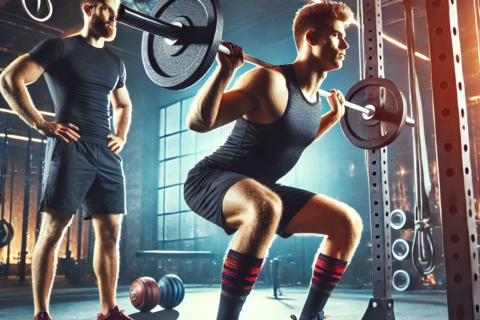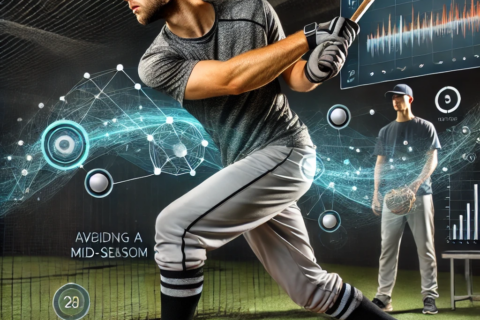Assess, Don’t Guess – Why We Go So In-Depth
Every athlete that comes through our doors goes through an assessment. This can be a 15 minute consultation, 90 minute general assessment, or 120 minute advanced assessment. Learn more about our assessment process here (link)
Why Do We Assess?
Every athlete is unique and deserves the time from our staff to determine where they fit best in our program. For our younger athletes this is as quick as a phone call, for our older athletes it is an in-depth motivational profiling, joint by joint assessment, and full skill assessment/breakdown using our gold standard technology. We call this the “Advanced Assessment.”

The Advanced assessment is at the core of everything we do. It starts with a 30 minute motivational profiling. This helps us understand where the athlete wants to go. If an athlete wants to be an MLB player, we need to design the plan and coach them much differently than a player who wants to make the freshman team at their high school.
Next, we spend 45-60 minutes going through our joint-by-joint assessment. This covers hip, spine, and shoulder range of motion. (We will go into more depth below.) We assess athletes as young as 12 years old. The reason why is we feel we need to have an objective starting point to know where we need to go and know what they want to achieve. Having an idea of where an athlete is before puberty is extremely important and helps us provide insight on how to reduce the chances of injury at a young age, build a stronger athletic base, and provide a clearer picture of where they are talent wise.
The next and last portion of the assessment is our skill screen. We take a look at how you move in the box and/or on the mound. This skill screen relies heavily on data. Why? We want to remove bias from the process of assessing athletes. All coaches and trainers have biases, it’s human nature. But by eliminating biases and relying on data, we can see more clearly where athletes are in their development. And then prescribe better training to improve their performance.
How KPI Screens Athletes
Injury History, Physical, Motivation Profiling
The physical screen starts off with background history. This includings training history, playing history, and injury history. We have to know where you’ve been, before we can know where we are going. We do this to gather as much information as an athlete and their parents can provide to gain full context on an athlete. If an athlete broke their ankle when they were 9 years old, the ligaments might still reflect that injury. Their radius or ulna bones may be slightly off-center or not straight. This would cause upstream changes in the way the arm works, how muscles function, shoulder flexibility and, ultimately, in how the athlete throws a ball or swings a bat. We want to know this history because all major or chronic injuries tend to show up in how an athlete moves.
Once we finish the background history, which usually takes about 5-10 minutes, we move onto our motivation profiling. This is the most important portion of the sit down, as it gives us more insight to where this athlete is at emotionally. This is much deeper than a goal setting session. We aim to gain an understanding of what motivates a player. Some athletes are motivated by what others think of them, others by personal improvement, and some are only there because their parents are making them. Understanding what motivates a player helps us determine what program fits them best within our system and it helps us get out on the right foot coaching wise. This usually takes about 10-20 minutes.

Next, we do a physical screen on a table, where we measure ranges of motion of all the pertinent joints of an athlete. This gives us a baseline of how an athlete is built. The hips, spine, and shoulders are the most important for baseball/softball players. We do not rely heavily on general movement screens, ie. squats, lunges, etc. because they don’t give us the full picture and we will teach them proper movements when they get into the gym. We would rather see how you swing/throw/pitch and then use that info to determine the areas you need to work on movement wise.
We have found that the physical screen allows us to clearly see how you are built. Almost always, there are things athletes are coached into or try to do that they aren’t built to do. This can increase the chances of acute/chronic injuries. No matter how old you are, your body reacts to the stress you put it under and this stress leaves a map for us to follow and understand how we can help you reach your full potential. The last part of our General Assessment is our Jump Profile. This is our newest component and allows us to see how an athlete is wired from a Central Nervous System (CNS) point of view. We include it as a part of our physical assessment because if we know how you are built, we know how you are wired, we will know what movement tendencies/compensations you will have in the box or on the mound.
How KPI Screens Athletes
Advanced Assessments, Swing & Pitching Screens
The Advanced Assessment is where we connect the dots between the general and the specific. Here we look at baseball/softball specific movements. This is simply the swing, throwing, and/or pitching motion for the athlete. The swing and throw are two of the fastest motions done in sport. They are a 3D, complex, and intricate movement. We must dive deeper than just watching an athlete hit or pitch and definitely owe more than just a video breakdown of a single execution of the skill.
We rely heavily on different pieces of tech to assess and provide objective data on how a player moves. We start capturing this data as soon as we start working with an athlete, but it takes a bit of time to build up a sufficient sample of their swing or throw to provide a complete picture. We take into account there may be some noise introduced into the equation by external factors that takes time to filter out. For example, most hitters struggle to acclimate to our cages when they come in for an assessment and the short amount of time we have to get swings they may fail to make good contact. Pitchers typically aren’t used to pitching to a target instead of a catcher. Those same athletes might be excellent players, but the change in environment and task at hand could change the way they perform.

On the pitching side of things we use Rapsodo and ProPlayAI to measure both the mechanics of a pitcher and their movement profile of each pitch. On the hitting side of things we use Blast Motion, to get an idea of what the bat does. We use K-Vest to measure the kinematic sequence of the swing, what the body does. And to complete the picture, we use Hittrax to capture ball flight data. All three of these things are needed to understand a hitter. The technology reduces bias, allows us to make objective assessments, design an individualized program, and retest to see if an athlete is progressing.


